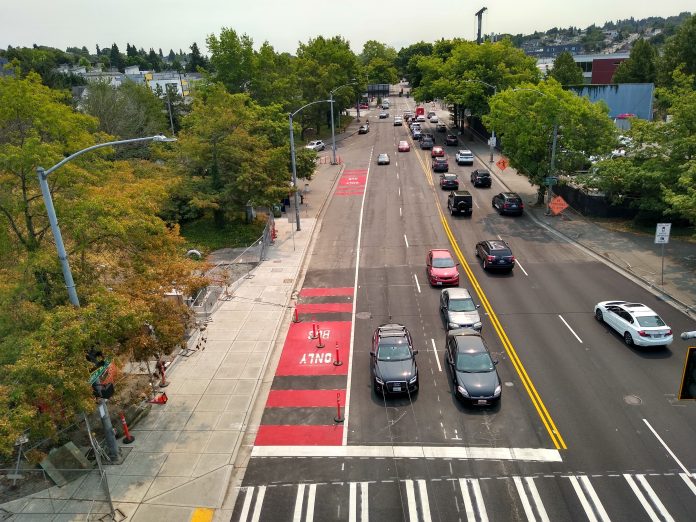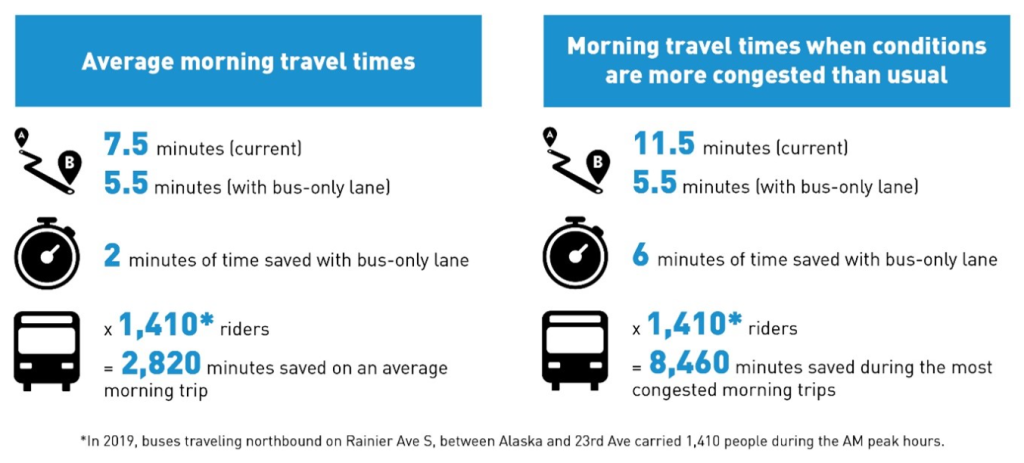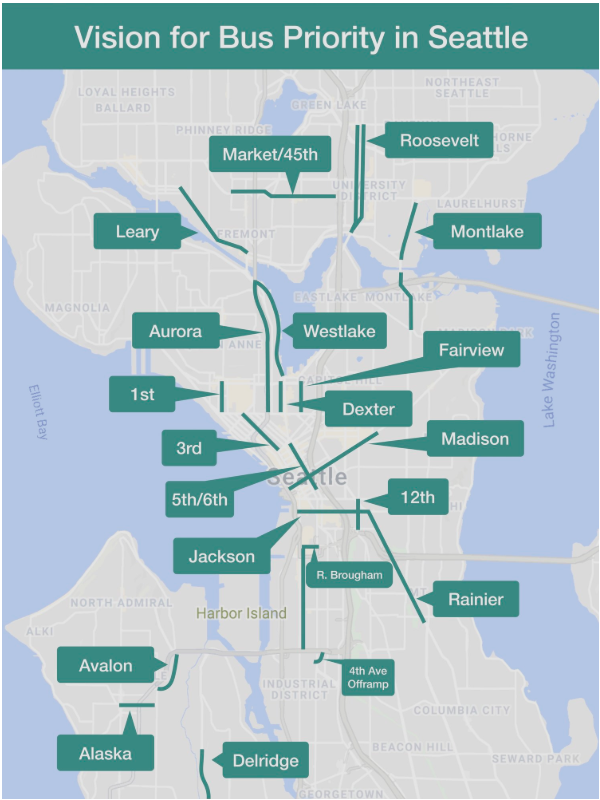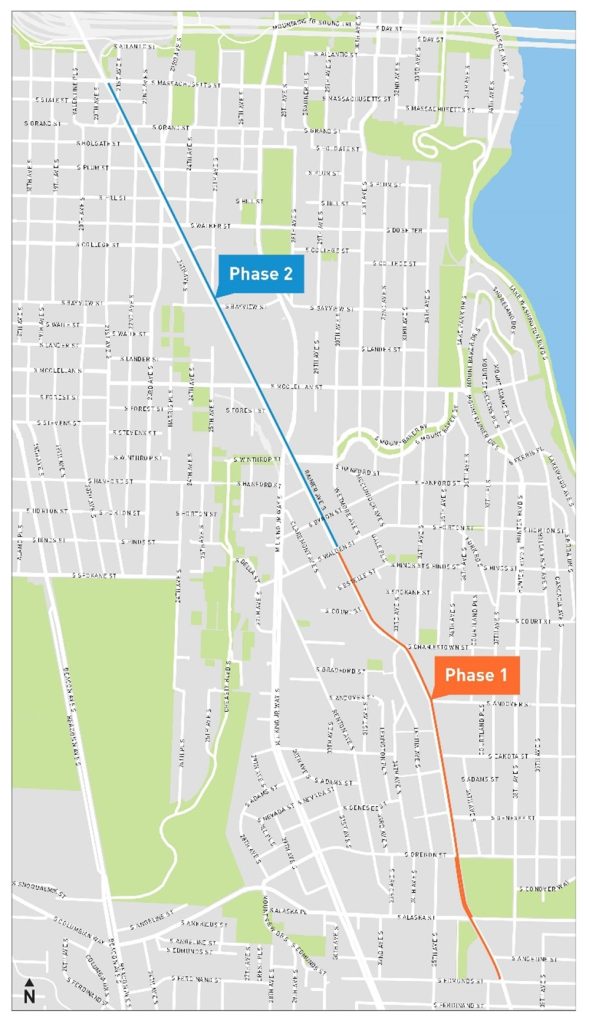
The Seattle Department of Transportation (SDOT) has announced they are planning to convert one lane of northbound Rainier Avenue to a dedicated transit lane between Columbia City and Mount Baker later this year. A planned extension north through a heavily congested section near I-90 to reach to the soon-to-open Judkins Park Station in the median of the freeway has been proposed, but not finalized.
SDOT says that the first phase of this transit lane could save riders on the Route 7 one minute per trip, but that the full extension could save riders 6 minutes during times of highest congestion on Rainier Avenue. That could translate to as many as 141 cumulative hours saved per day, given the ridership of that highly used bus route. Even as the pandemic and work-from-home measures have temporarily sapped ridership across much of the bus network, ridership on Route 7 has remained high due to prevalence of transit-dependent households and essential workers along the route, Metro reports.

The first phase, between S Alaska Street and S Walden Street, will be implemented this year, SDOT said, and will also include a short stretch of southbound bus-only lane between S Oregon Street and S Edmonds Street in Columbia City. These bus lanes come on top of additional ones that have been added south of Columbia City as part of previous street revamps, intended to improve safety along the dangerous corridor. The second phase of northbound bus lane will begin outreach this year, but could be installed as late as 2024.
With this announcement, SDOT is once again shutting down the idea of dedicating any space on Rainier Avenue to people on bikes, despite there being very few alternative routes in the area that are as flat and direct. The Rainier Valley neighborhood greenway was created as a circuitous alternative to Rainier Avenue, but has some incredibly steep segments, and SDOT has been unable to get the Washington State Department of Transportation (WSDOT) to allow for construction of a connection to the I-90 trail as was previously envisioned.
Protected bike lanes were included as an early alternative in some of the previous Rainier Avenue redesigns further south on the corridor, but along the way have been discarded and deprioritized by SDOT’s plans for the corridor.
“We’ve heard that Rainier Ave S is an important street for people biking because it is often the flattest and most direct route. Rainier Ave S is also an important and frequently used route for transit, freight, and other vehicles,” SDOT notes on the project website. “We must balance these needs and priorities when making decisions about changes to the street and the limited right-of-way space. To date, we’ve heard that the community’s top two priorities for Rainier Ave S are to reduce crashes and keep buses moving.”
An unstated goal of the community is also to conserve parking: no on-street parking would be removed to make room for bus lanes on the corridor, at least in phase 1.
“While bike lanes are not currently planned for Rainier Ave S, nor are they included in the Bike Master Plan, we are making other changes to Rainier Ave S that will improve conditions for people walking, biking, and rolling. Many of these improvements are being constructed with other nearby projects including the Route 7 Transit-Plus Multi-Modal Corridor,” SDOT wrote. In fact, protected bike lanes on Rainier Avenue are envisioned on the 2014 Bicycle Master Plan north of MLK Jr Way S.

That northern segment of Rainier is the stretch with the highest traffic volumes, which explains why a dedicated transit lane is not proposed north of I-90 even as the Route 7’s overall reliability and corridor-length travel times will continue to be impacted by this lack of priority. Southbound evening traffic volumes are also to blame for the lack of any proposal for southbound transit lane to compliment the northbound, when the high volumes are clear evidence that the bus needs to be prioritized. The Move All Seattle Sustainably coalition (MASS), of which The Urbanist is a member, has called for bus lanes to be expanded and connected to a broad network of bus lanes making the entire transit system more immune to traffic congestion.
Could Rainier Avenue ultimately see bus lanes for its entire length? With the right leadership, the opportunity could come soon. In 2020, King County Metro paused work on the RapidRide R line, which would have converted the route to a full RapidRide line. In April, the King County Regional Transit Committee was briefed on the status of the line, but none of the three Seattle representatives on the committee — Councilmembers Dan Strauss, Alex Pedersen, or Sara Nelson — were present for the briefing. The transit agency identified the line (along with Kirkland’s K line) as one of its top priorities for the next phase of RapidRide expansion, which has been delayed by pandemic-related funding shortfalls.

It will likely take a new allocation of funding, either from the County, the City of Seattle, or both, to move forward with conversion of the route to RapidRide. However, outreach may need to do a better job of winning over Route 7 riders, who were understandably against proposals to consolidate stops along this well-used route because of the increase the changes would create for walk times.
Elsewhere on Rainier Avenue, the SDOT Vision Zero team will be kicking off work this year on a third phase of safety improvements, which is expected to involve a rechannelization of the street’s southern segment through Rainier Beach. This continues the piecemeal approach that is now continuing under a third mayor. A comprehensive safety overhaul for the busy northern segment in the form of Accessible Mount Baker has been mostly dormant for years now, though some spot improvements are as soon as this year. SDOT considered applying for a federal grant this year to expedite that work, but decided against it.
In 2017, after a crash at Rainier and Henderson Street in Rainier Beach injured two ten-year-old girls, Mayor Jenny Durkan attended a rally and vaguely committed to making safety improvements to the street. However, the only changes resulting from that tragedy were a set of flex-posts added at that specific intersection were destroyed within a few months and never replaced.
The Durkan administration ultimately punted any major improvements to Rainier to the Harrell administration, if not beyond. Similarly squishy were Durkan’s commitments toward the City’s Vision Zero goal of ending traffic deaths and serious injuries — and hence traffic fatalities were on an upward trend as she left office.
While we wait for the City of Seattle to present a full and unified vision for the Rainier Avenue corridor that aligns with the city’s goals around moving people and prioritizing safety, adding bus lanes as fast as possible in order to prioritize transit riders on one of King County Metro’s most important routes is essential.
Ryan Packer lives in the Summit Slope neighborhood of Capitol Hill and has been writing for the The Urbanist since 2015. They report on multimodal transportation issues, #VisionZero, preservation, and local politics. They believe in using Seattle's history to help attain the vibrant, diverse city that we all wish to inhabit. Ryan's writing has appeared in Capitol Hill Seattle Blog, Bike Portland, and Seattle Bike Blog, where they also did a four-month stint as temporary editor.




